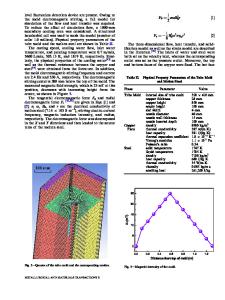Mathematical simulation on coupled flow, heat, and solute transport in slab continuous casting process
- PDF / 486,364 Bytes
- 12 Pages / 612 x 792 pts (letter) Page_size
- 94 Downloads / 501 Views
I.
INTRODUCTION
CONTINUOUS casting of steel is essentially the solidification of the multicomponent system. During solidification, latent energy is released at the interface, which separates the phases within the mushy zone. The distribution of this energy therefore depends on the specific structure of the multiphase region. Latent energy released during solidification is transferred by conduction in the solid phase, as well as by the combined effects (conduction and convection) in the liquid phase. Fluid flow is mainly induced by the inertia force of the nozzle flow, thermal and concentration buoyancy forces, and thermal contraction of solid shell due to the phase transformation. Concentration variations are primarily due to differences in the solubilities of constituents within each phase. Such differences lead to the selective rejection of constituents at microscopic phase interfaces. The rejected constituents are transported by fluid convection and, to a lesser extent, by diffusion within the phases, which leads to the redistribution of solute on macroscale, the so-called macrosegregation. Fluid flow inside the cast strand directly affects the floatation of inclusions, temperature distribution, growth of solid shell, solute and mass distribution, and so on. So studies on the fluid flow features under different operational conditions have drawn wide attention in recent years. The thickness and shape of the solid shell in the mold and at the mold exit directly affect the possibility of the fatal ‘‘breakout.’’ Besides the heat transfer between the mold wall and solid shell, the temperature distribution inside the cast strand also has a great effect on the thickness and shape of the solid shell. This means that the shape of HONGLIANG YANG, Doctoral Student, and XINGZHONG ZHANG, KAIWEN DENG, WENCAI LI, and YONG GAN, Professors, are with the National Research and Engineering Center for Continuous Casting Technology, No. 76 Xueyuan Nanlu, Haidian District, Beijing, 100081, People’s Republic of China. LIANGANG ZHAO, Senior Engineer, is with Anshan Iron and Steel Corporation, Anshan, Liaoning, People’s Republic of China. Manuscript submitted December 8, 1997. METALLURGICAL AND MATERIALS TRANSACTIONS B
the solid shell could be controlled by changing the temperature distribution in the melt pool. Solute and mass distribution directly affects the floatation of inclusions and segregation of alloying elements, and it is mainly induced by the fluid flow, heat transfer, and solidification process. This means that the improvement of the removal of inclusions and segregation can be reached via improving the feature of fluid flow and the solidification process. Experimental studies[1,2] have shown that macrosegregation in the continuous cast semis is influenced by the thermophysical properties and composition of steel, strand geometry, and operational parameters. Thus, the casting conditions should be strictly controlled in order to improve the steel quality. An understanding of the transport phenomena in the continuous castin
Data Loading...











